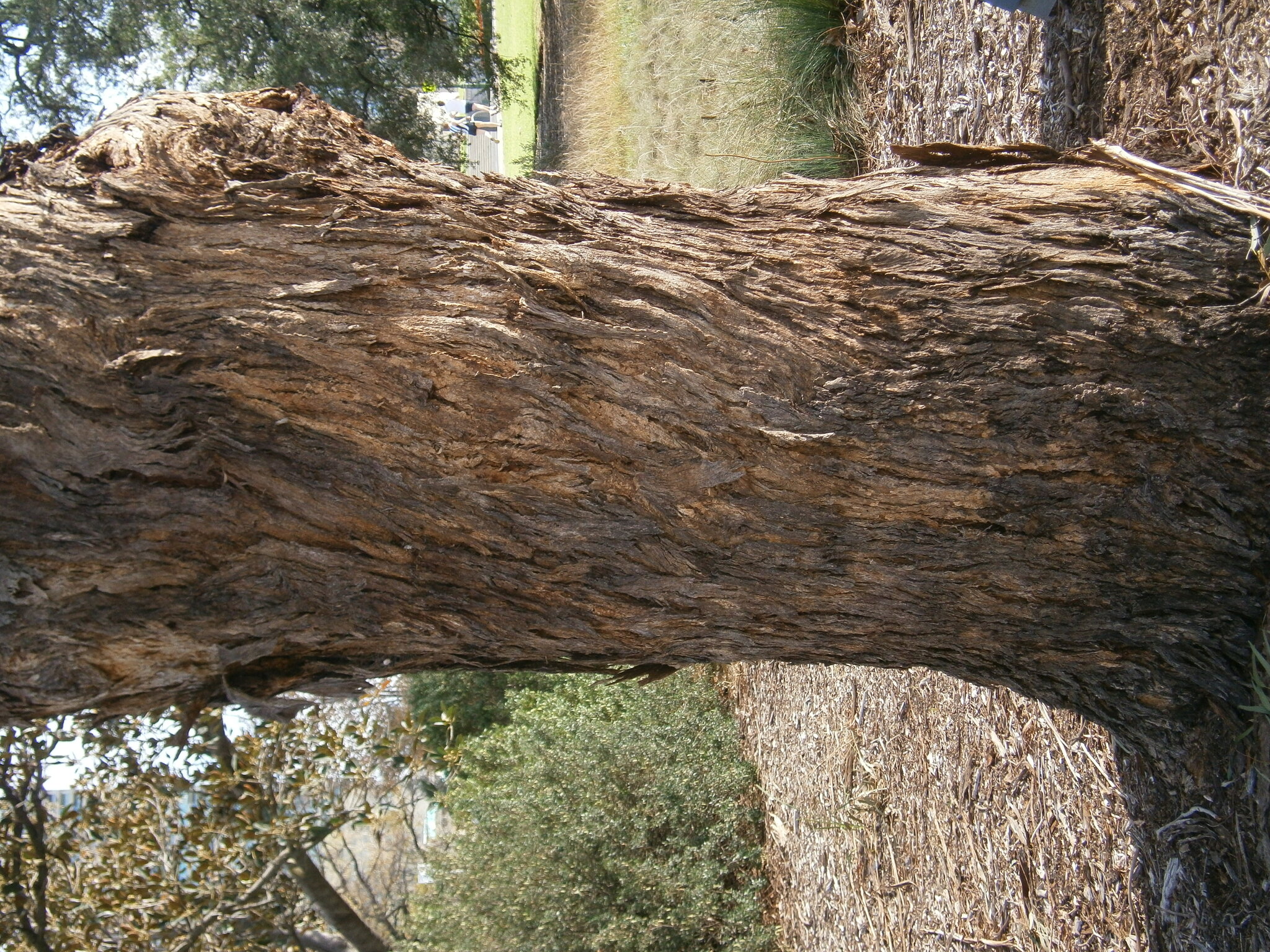
Greek eu — well, kalyptos — covered, referring to the cap or lid which covers the stamens in the bud.
Trees, shrubs or mallees, sometimes with drought- or fire-resistant lignotubers. Bark smooth, fibrous, stringy or patterned. Leaves passing through a phased development, juvenile leaves often quite different from the adult ones (but occasionally persisting on the mature tree), mostly alternate, stalked, sickleshaped and pendulous. Flowers in clusters, (rarely solitary) usually with a common stalk and mostly in groups of (3)-7(-20 or more). Sepals and/or petals forming a single or double lid or cap (calyptra or operculum) on top of the flower that is shed when the bud bursts, the double calyptra leaving a scar. Stamens numerous. Fruit a capsule with valves that sometimes protrude.
A large and variable genus (in Australia this genus is second only to Acacia in numbers) grown for the attractive overall habit, bark, foliage, flowers and fruit, also for the cultural identification with the Australian landscape. Much of the diversity of cultivated species to be found in Victoria can be attributed to the State Schools Nsy, which has grown and distributed many unusual species to school grounds. Eucalyptus microcorys F. Muell., Tallow-wood, from Qld and NSW is grown in warmer districts for the wood, honey and ornamental value and is also popular overseas; it has flowers in what appear to be large terminal clusters. In Victoria there are specimens at Memorial Park Ivanhoe, St Andrews Church, Brighton, and Gordon Grove, S Yarra.
See Corymbia treatment for comments on the splitting of Eucalyptus into segregate genera.
Seed, although various vegetative methods are under research.
The foliage for the cut flower industry (ornamental coppiced plants are a good source of juvenile foliage); other parts, especially fruits, are used in arts and crafts; timber for construction, fuel and paper pulp; eucalyptus oil is used medicinally, for disinfectants, deodorants, perfumes, stain removers etc. and is extracted from the leaves (Australia produces only 5% of the world supply); the flowers are a valuable source of honey. Eucalypts have been grown widely overseas (to the point of becoming weedy in some places, e.g. California), not only for amenity planting but to drain swamps (see Zacharin, 1978).
About 720 species, mostly Australian, a few from Timor and the Lesser Sunda Islands, Celebes, New Guinea, New Britain and the Philippines (all E of Wallace's Line). The greatest diversity occurs in coastal NSW and SW WA.
Identification and Classification: Costermans (1983) Brooker & Kleinig (1983, 1990, 1994), Chippendale (1988), McMahon (1990), Hill & Johnson (1995). A CD-ROM key to species in SE Australia called EUCLID (Brooker et al. 1997) is available from the Centre for Plant Biodiversity Research in Canberra. Illustrations and Cultivation: Chippendale (1968); Kelly (1978); Holliday & Watton (1985) (colour pictures of most of those in cultivation), Elliot & Jones (1986, detailed background information on uses, propagation and pests and diseases).
VIC: A good Australia-wide collection can be seen at Peter Francis Points Arboretum, Coleraine, Vic, while Victorian species have been accumulated at the Ian Nankervis Reserve, Burnley and the La Trobe University Campus. Some rare and ornamental species can be seen at Maranoa Gds, Balwyn. SA: The Waite Arboretum in Glen Osmond, Adelaide, has one of Australia's finest collections with 254 species and subspecies in 1989: the larger trees were planted in 1949 (about 70 species) and the mallees planted in 1955 (about 160 species). NSW: 95 species can be seen at the Cumberland Arboretum, Pennant Hills, as well as a selection in the Bot. Gds in the city, also at Mt Annan (about 300 species) and Mt Tomah.
Victoria has about 120 species that are indigenous to the State - more than the total number of commonly grown ornamental species used in SE Australia. Indigenous trees are now used widely for landscape unity and ecological balance and, of course, there are also many species that may be encountered as occasional plantings, but which are very rare in cultivation. Eucalypt identification often requires information not only about mature leaves, fruits and flower buds but also the bark and habit.
Habit - whether multiple-trunked from the base - the mallee habit (the mallee root or lignotuber from which it can regenerate after fire), or single-trunked.
Bark type - although, for simplicity, not referred to in the key, the following are some of the basic bark types: gum bark - smooth on most of the trunk (occasionally not at very base) and branches, some shade of grey or cream; box bark- rough, flaky, scaly or fibrous over the whole trunk, may be smooth on the branches; stringybark - rough, in long, furrowed strands; ironbark - rough, hard, black, thick and deeply furrowed as far as the small branchlets.
Branchlets - can sometimes be split to reveal oil glands inside.
Leaves - shape, size, length of stalk; number and angle of veins and whether they are easily visible or not; number of oil dots on the surface. Care should also be taken when leaves are opposite to determine sure whether they are juvenile trees or members of the genus Angophora.
Flower buds and fruits - The number of flower buds and fruits is fairly consistent on each common stalk (peduncle) although care should be taken to look for and include the scars of those that have fallen off.
Source: (2002). Eucalyptus. In: . Horticultural Flora of South-eastern Australia. Volume 3. Flowering plants. Dicotyledons. Part 2. The identification of garden and cultivated plants. University of New South Wales Press.
Updated by: Val Stajsic, November 2017
